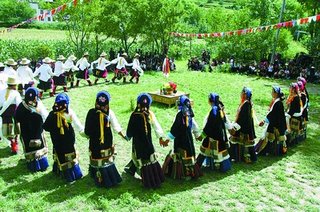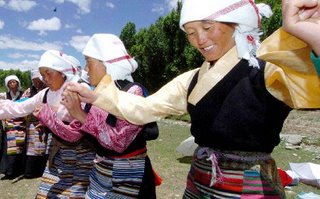Tibetan Dances


Nearly every Tibetan can sing and dance. They sing anytime for any event and dance at festivals, weddings, gatherings and during their spare time. The Tibetan nationality, or Bo as it calls itself, has a population of about 3.87 million, scattered in Tibet, Gansu, Sichuan and Yunnan, which are known for their highlands, grasslands, thick forests and abundant natural resources. The areas inhabited by Tibetans boats a great diversity of folk songs and dances.
From historical writings we can see that more than a thousand years ago folk religious and sorcerers' dances were very popular in Tibet. They influenced the Wild Bull Dance, Yak Dance, Deer Dance, Crane Dance, Peacock Dance, Sorcerers' Dance, Drum Dance and other kinds of folk dances that have been handed down to this day.
Here we will introduce you some of the early dances popular among Tibetans:
Guoxie Dance
Guoxie (meaning "village" in Tibetan) is a group dance popular in rural areas of Tibet. The participants dance hand in hand and sing in rotation. The dance is often seen in villages, on open squares and threshing grounds. At festivals people dance and sing from sunset to sunrise. They mark the rhythm by stamping their feet.
Guoxie is performed to a 2/4 beat with the stress on the first beat. The steps are steady and vigorous, characterized by a marked tempo and a strong sense of people's labour and life. The underlying characteristic of the dance is the expression of collective enthusiasm and joy. This dance is found everywhere in Tibet, but the most renowned version is found in the Shannan area. The form is largely as follows:
At festivals men and women stand hand in hand in two lines around a big vat of highland-barley wine placed on open ground. The two groups first sing and walk from left to right in a circle. When they finish singing, the xieben, or organizer of the dance, leads in shouting, "Xiu, xiu, xiu, xiu," and starts the dance with rhythmic steps. This rhythmic shouting is called xiege in Tibetan, or "beginning of the song," which is followed closely by quick-tempo singing and dancing. The two lines of men and women compete in their dancing. After repeated dancing the xieben leads in shouting, "Xiu, xiu, xiu, xiu," or sings alone while the others dance to his tempo. This part of the dance is called xiexiu, or finale.




0 Comments:
Post a Comment
<< Home